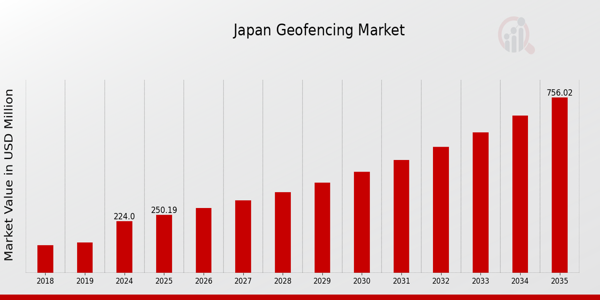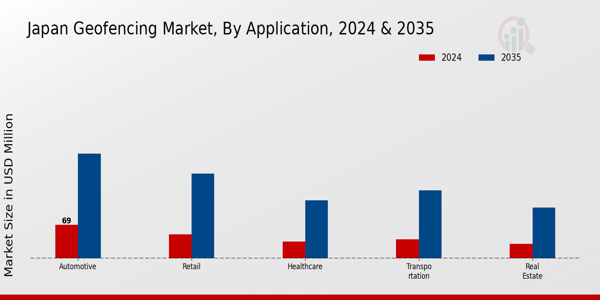Japan Geofencing Market Overview
As per MRFR analysis, the Japan Geofencing Market Size was estimated at 204.05 (USD Million) in 2023.The Japan Geofencing Market Industry is expected to grow from 224(USD Million) in 2024 to 756 (USD Million) by 2035. The Japan Geofencing Market CAGR (growth rate) is expected to be around 11.693% during the forecast period (2025 - 2035).
Key Japan Geofencing Market Trends Highlighted
Thanks mostly to the growing acceptance of mobile technology and the expansion of location-based services, the geofencing sector is witnessing notable expansion in Japan. With rising reliance on cell phones by Japanese consumers, companies are using geofencing to instantly interact with consumers. More businesses are investing in geofencing technology as a result of the need for tailored advertising and customized marketing solutions, therefore improving their capacity to interact with customers successfully. Furthermore, Japan's metropolitan population—densely inhabited cities—offers a rich terrain for geofencing uses, therefore enabling companies to increase their reach and enhance client interaction.
Still, there are plenty of opportunities within the Japan geofencing industry, especially in retail, hotel, and transportation. Businesses might investigate loyalty programs and location-based marketing to boost sales and client retention. Moreover, the growing reach of the Internet of Things (IoT) in Japan presents opportunities for creative geofencing solutions able to interact with public transit systems and smart city projects. Geofencing is a strategic benefit for local governments and companies as this integration may improve urban planning and service delivery. Recent trends show a move toward geofencing solutions with enhanced data analytics and machine learning capability.
Analysing customer behavior is becoming more and more important for Japanese companies in order to develop customized and more successful marketing plans. Technological developments have raised the precision and efficiency of geofencing systems, thereby enabling exact targeting and involvement. The increasing focus on privacy and data security also influences how businesses handle geofencing, which drives a trend toward open policies fostering customer confidence in an extremely competitive market. The course of the geofencing industry in Japan will remain shaped by the junction of technology, customer behavior, and legal issues.

Source: Primary Research, Secondary Research, Market Research Future Database and Analyst Review
Japan Geofencing Market Drivers
Rise in Mobile Advertising Expenditure
The Japan Geofencing Market Industry is significantly benefitting from the rise in mobile advertising expenditure, which has grown substantially in recent years. According to the Ministry of Internal Affairs and Communications (MIC) of Japan, mobile advertising spending in Japan has consistently increased, reaching approximately 700 billion JPY in 2022.
This growing trend can be attributed to businesses increasingly recognizing the importance of location-based marketing techniques.Major advertising firms such as Dentsu Inc. are investing heavily in campaigns that utilize geofencing technology to target consumers more effectively based on their real-time locations. As mobile penetration continues to exceed 90% in Japan, the potential reach for geofencing applications remains high, further driving market growth. It is anticipated that as brands continue to embrace geofencing, the need for innovative location-based marketing solutions will rise, offering tremendous opportunities for the Japan Geofencing Market Industry.
Increased Adoption of Smart Devices
The rapid adoption of smart devices in Japan is serving as a key driver for the Japan Geofencing Market Industry. As reported by the Ministry of Internal Affairs and Communications, the number of smartphone users in Japan reached over 80 million in 2022, representing a market penetration rate of around 72%.
This rise in smartphone usage directly correlates to increased opportunities for geofencing applications that leverage GPS and Bluetooth technologies.Companies like Fujitsu and Sony are advancing smart device capabilities that enhance the geofencing experience. Furthermore, this shift toward smart devices fosters a more engaged user base, which in turn encourages businesses to adopt geofencing strategies to reach consumers with high precision. Such trends indicate a robust growth trajectory for the Japan Geofencing Market Industry.
Growing Demand for Enhanced Customer Engagement
The drive for enhanced customer engagement is a prominent factor influencing the growth of the Japan Geofencing Market Industry. According to a survey conducted by the Japan Marketing Association, over 65% of Japanese consumers reported a preference for brands that employ location-based engagement strategies. Businesses are increasingly recognizing that geofencing can provide personalized marketing messages directly based on a customer’s location, thereby enhancing customer interaction.
Leading companies like Rakuten are utilizing geofencing technology to deliver special offers to users as they enter specific geographical areas. The effectiveness of such targeted marketing initiatives contributes significantly to customer retention and brand loyalty. As the market becomes increasingly competitive, the demand for innovative customer engagement solutions will further amplify the growth of the Japan Geofencing Market Industry.
Japan Geofencing Market Segment Insights
Geofencing Market Application Insights
The Application segment of the Japan Geofencing Market showcases a diverse and dynamic landscape, driven by the increasing adoption of location-based services across various industries. As the digital ecosystem evolves, businesses in the retail sector have started utilizing geofencing technologies to offer targeted promotions and enhance customer engagement.
This trend significantly impacts consumer behavior, allowing retailers to reach potential clients within designated geographic boundaries, ultimately increasing foot traffic and sales conversion rates.In the realm of transportation, geofencing plays a crucial role in optimizing fleet management and enhancing safety; by integrating geofencing capabilities, companies can track vehicle locations and establish alerts for unauthorized movements, thereby improving logistics efficiency and reducing operational costs.
The healthcare industry in Japan is also witnessing a surge in the application of geofencing, specifically in patient management and emergency response. Hospitals are utilizing this technology to monitor patients' proximity to medical facilities, enabling efficient resource allocation and prompt interventions during emergencies.Moreover, real estate companies leverage geofencing to enhance property marketing strategies, allowing potential buyers to receive information about available listings when they are in proximity to various locations, thereby streamlining the home-buying process. The automotive sector is further driving growth in this market by implementing geofencing features for smart navigation and connected vehicle technologies.
This integration enables drivers to receive important alerts regarding local traffic regulations, nearby services, or offers from local businesses.
As the demand for innovative solutions increases, the Japan Geofencing Market is expected to expand significantly, highlighting the importance of each application segment in delivering tailored experiences and maximizing operational efficiency across various sectors. Market participants must stay abreast of these developments and work collaboratively to further enhance capabilities in order to capitalize on the growing opportunities within the Japanese landscape. With ongoing advancements and innovation, the potential for sector-wide growth remains substantial, suggesting that businesses across various industries will increasingly explore geofencing as a vital component of their strategies moving forward.

Source: Primary Research, Secondary Research, Market Research Future Database and Analyst Review
Geofencing Market Technology Insights
The Technology segment of the Japan Geofencing Market is characterized by its rapid growth and adaptation to a variety of applications across different industries. Japan's commitment to technological advancement, backed by strong infrastructure, enables the adoption of various technologies like GPS, RFID, Beacons, Cellular, and Wi-Fi within geofencing solutions. GPS technology plays a vital role as it allows precise location tracking, widely used in logistics and transportation sectors.
RFID technology has gained traction in retail, enhancing inventory management and customer experiences.The utilization of Beacons has transformed marketing strategies, enabling businesses to reach customers with tailored offers based on proximity. Cellular networks facilitate geofencing in areas where GPS is less effective, ensuring connectivity and uninterrupted service. Wi-Fi technology further complements these solutions, especially in urban areas, allowing businesses to engage with consumers through targeted promotions.
The integration of these technologies creates a robust framework for location-based services, thereby driving the overall growth of the Japan Geofencing Market.Trends indicate a shift towards seamless integration of these technologies to enhance customer experiences and operational efficiencies, contributing to the evolution of location-based applications in Japan.
Geofencing Market End Use Insights
The Japan Geofencing Market is experiencing robust growth driven by various end-use applications, notably in the Consumer, Enterprise, and Government sectors. In the Consumer segment, the adoption is significant as businesses leverage geofencing to enhance customer engagement and personalized marketing strategies, catering to a tech-savvy population. The Enterprise sector plays an equally critical role by implementing geofencing solutions to improve operational efficiencies, asset tracking, and workforce management, thereby enhancing productivity and reducing costs.
Meanwhile, the Government sector utilizes geofencing for public safety, urban planning, and managing utilities, showcasing its importance in regional development and enhancing citizen security. Collectively, these segments illustrate the varied applications of geofencing technology, contributing to the Japan Geofencing Market's overall expansion. Additionally, the increasing penetration of smartphones and Internet of Things (IoT) devices in Japan is driving demand across all segments, further positioning the market for sustained growth. As industries adopt data-driven solutions, the integration of geofencing is set to be a transformative force across these end-use categories, fueling market statistics and overall development in Japan.
Geofencing Market Deployment Mode Insights
The Japan Geofencing Market, particularly in the Deployment Mode segment, is witnessing significant advancements driven by the proliferation of mobile devices and location-based services. This segment is primarily categorized into Cloud and On-Premises models, both of which play crucial roles in the implementation of geofencing solutions. The Cloud deployment mode is gaining traction due to its scalability, flexibility, and cost-effectiveness, enabling businesses to streamline their operations while accessing real-time data efficiently.
On the other hand, the On-Premises deployment mode appeals to organizations that prioritize data security and have stringent compliance requirements, allowing them to maintain control over their geofencing applications within their own infrastructure.The hybrid growth of both models reflects the diverse needs of various industries in Japan, ranging from retail to logistics, where geofencing solutions enhance customer engagement and operational efficiency. The increasing adoption of smart technologies and a growing focus on personalized marketing are expected to further drive the demand for geofencing solutions in both deployment modes across Japan.
Japan Geofencing Market Key Players and Competitive Insights
The Japan Geofencing Market is witnessing significant growth, driven by advancements in location-based services and increasing demand for personalized marketing solutions. As businesses seek to enhance customer engagement and improve operational efficiency, geofencing has emerged as a vital tool in the competitive landscape. Companies operating in this market are leveraging data analytics, mobile technology, and artificial intelligence to create innovative solutions that cater specifically to the needs of Japanese consumers.
The competitive insights reveal a dynamic environment where businesses are not only focused on technological advancements but also on understanding consumer behaviors and preferences, making it crucial to stay ahead of trends and shifts in the market.
Xactly is carving out an impressive presence within the Japan Geofencing Market, showcasing its strengths in data-driven decision-making and performance management solutions. With a strong emphasis on sales performance optimization, Xactly provides organizations with tools to analyze geolocation data and design effective geofencing strategies. The company’s unique selling propositions include its ability to integrate with existing enterprise systems and its commitment to enhancing revenue generation through location intelligence. Additionally, Xactly’s focus on customer relationship management enables businesses to harness location data for targeted marketing efforts, thereby creating tailored experiences for consumers in Japan.
As companies increasingly adopt data-centric approaches, Xactly’s capabilities in geofencing not only enhance operational outcomes but also position it as a formidable player in the local market.
Geogram stands out in the Japan Geofencing Market with its innovative suite of location-based services designed for businesses seeking to optimize customer interactions. The company offers an array of key products, including customizable geofencing applications and analytics tools that empower businesses to create targeted campaigns based on geographic locations. Geogram’s strong market presence is underscored by its partnerships with local businesses, which facilitate seamless integration of geofencing solutions into various industries, such as retail and hospitality.
A key strength of Geogram lies in its ability to adapt to the unique preferences of the Japanese market, effectively driving engagement through localized marketing tactics. Furthermore, the company's strategic alliances and potential mergers and acquisitions in the region signal its commitment to expanding market reach and enhancing service offerings, thus solidifying its competitive edge in the geofencing landscape of Japan.
Key Companies in the Japan Geofencing Market Include:
- Xactly
- Geogram
- Geollect
- Zenrin
- GroundLocation
- Bluesky
- Zebra
- Mediacube
- Sensonix
- HULU
- AirMap
- Foursquare
- Pusher
- Inrix
- Mapbox
Japan Geofencing Market Industry Developments
Recent developments in the Japan Geofencing Market have shown significant growth, particularly in sectors such as retail and transportation. Companies like Geollect and Zenrin are actively enhancing their geolocation services to integrate with various smart city initiatives across Japan, driven by the government's push for digital transformation in urban management.
In August 2023, AirMap expanded its services in Japan, focusing on drone navigation and management, which directly ties into geofencing applications for regulatory compliance and safety management. Furthermore, the collaboration between Xactly and Foursquare aims to improve location-based analytics for businesses, enhancing customer engagement strategies. As for mergers and acquisitions, no recent publicly known mergers or acquisitions related to the specified companies in the Japan Geofencing Market have been recorded.
However, market analysts highlight a growing interest in partnerships to leverage advanced technologies, including Artificial Intelligence and machine learning, which are becoming pivotal for enhancing accuracy in geofencing solutions. The Japan Geofencing Market continues to see technological advancements, with key players innovating to meet the demands of evolving consumer behaviors and regulatory frameworks.
Japan Geofencing Market Segmentation Insights
Geofencing Market Application Outlook
- Retail
- Transportation
- Healthcare
- Real Estate
- Automotive
Geofencing Market Technology Outlook
- GPS
- RFID
- Beacons
- Cellular
- Wi-Fi
Geofencing Market End Use Outlook
- Consumer
- Enterprise
- Government
Geofencing Market Deployment Mode Outlook
| Report Attribute/Metric Source: |
Details |
| MARKET SIZE 2023 |
204.05(USD Million) |
| MARKET SIZE 2024 |
224.0(USD Million) |
| MARKET SIZE 2035 |
756.0(USD Million) |
| COMPOUND ANNUAL GROWTH RATE (CAGR) |
11.693% (2025 - 2035) |
| REPORT COVERAGE |
Revenue Forecast, Competitive Landscape, Growth Factors, and Trends |
| BASE YEAR |
2024 |
| MARKET FORECAST PERIOD |
2025 - 2035 |
| HISTORICAL DATA |
2019 - 2024 |
| MARKET FORECAST UNITS |
USD Million |
| KEY COMPANIES PROFILED |
Xactly, Geogram, Geollect, Zenrin, GroundLocation, Bluesky, Zebra, Mediacube, Sensonix, HULU, AirMap, Foursquare, Pusher, Inrix, Mapbox |
| SEGMENTS COVERED |
Application, Technology, End Use, Deployment Mode |
| KEY MARKET OPPORTUNITIES |
Retail industry location-based promotions, Smart city infrastructure development, Location-based mobile advertising growth, Enhancing customer engagement strategies, Rise of autonomous delivery services |
| KEY MARKET DYNAMICS |
Technological advancements, Increasing smartphone penetration, Retail sector growth, Enhanced data analytics, Demand for targeted advertising |
| COUNTRIES COVERED |
Japan |
Frequently Asked Questions (FAQ):
The Japan Geofencing Market is expected to be valued at 224.0 USD Million in 2024.
By 2035, the Japan Geofencing Market is projected to grow to 756.0 USD Million.
The expected CAGR for the Japan Geofencing Market from 2025 to 2035 is 11.693%.
The Automotive application segment is expected to dominate with a valuation of 216.0 USD Million by 2035.
The Retail application segment is projected to reach 175.0 USD Million in 2035.
The Transportation segment is anticipated to have a market value of 140.0 USD Million by 2035.
The Healthcare application segment is expected to be valued at 120.0 USD Million in 2035.
Key players in the market include Xactly, Geogram, and Zenrin among others.
The Real Estate segment is projected to grow to 105.0 USD Million by 2035.
Challenges such as privacy concerns and technological integration may impact market growth.
















